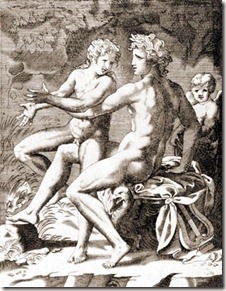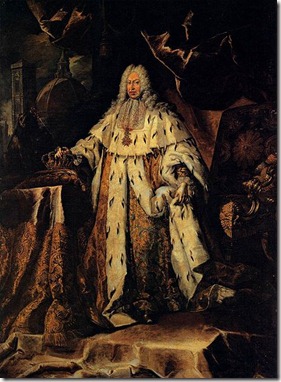The House of Medici or de' Medici was a political dynasty, banking family and later royal house that first began to gather prominence under Cosimo de' Medici in the Republic of Florence during the late 14th century.  The family originated in the Mugello region of the Tuscan countryside, gradually rising until they were able to found the Medici Bank. The bank was the largest in Europe during the 15th century, seeing the Medici gain political power in Florence— though officially they remained simply citizens, rather than monarchs. The Medici produced four Popes of the Catholic Church and in 1531 the family became hereditary Dukes of Florence. In 1569, the duchy was elevated to a grand duchy after territorial expansion. They ruled the Grand Duchy of Tuscany from its inception until 1737, with the death of Gian Gastone de' Medici. The grand duchy witnessed degrees of economic growth under the earlier grand dukes, but by the time of Cosimo III de' Medici, Tuscany was fiscally bankrupt.
The family originated in the Mugello region of the Tuscan countryside, gradually rising until they were able to found the Medici Bank. The bank was the largest in Europe during the 15th century, seeing the Medici gain political power in Florence— though officially they remained simply citizens, rather than monarchs. The Medici produced four Popes of the Catholic Church and in 1531 the family became hereditary Dukes of Florence. In 1569, the duchy was elevated to a grand duchy after territorial expansion. They ruled the Grand Duchy of Tuscany from its inception until 1737, with the death of Gian Gastone de' Medici. The grand duchy witnessed degrees of economic growth under the earlier grand dukes, but by the time of Cosimo III de' Medici, Tuscany was fiscally bankrupt.
Their wealth and influence initially derived from the textile trade guided by the guild of the Arte della Lana. Like other signore families they dominated their city's government. They were able to bring Florence under their family's power, allowing for an environment where art and humanism could flourish. They fostered and inspired the birth of the Italian Renaissance along with other families of Italy, such as the Visconti and Sforza of Milan, the Este of Ferrara, and the Gonzaga of Mantua.
 Gian Gastone de' Medici (Giovanni Battista Gastone; 24 May 1671 – 9 July 1737) was the seventh and last Medicean Grand Duke of Tuscany. He was the second son of Cosimo III de' Medici, Grand Duke of Tuscany, and Marguerite Louise d'Orléans, Princess of France. His sister, Anna Maria Luisa de' Medici, the Electress Palatine, married him to Anna Maria Franziska of Saxe-Lauenburg, a wealthy widow, in 1697. Unfortunately, Gian Gastone despised his new wife, and she, him. The union produced no offspring. As Grand Prince Ferdinando, Gian Gastone's elder brother, predeceased Cosimo III, Gian Gastone succeeded his father as Grand Duke in 1723.
Gian Gastone de' Medici (Giovanni Battista Gastone; 24 May 1671 – 9 July 1737) was the seventh and last Medicean Grand Duke of Tuscany. He was the second son of Cosimo III de' Medici, Grand Duke of Tuscany, and Marguerite Louise d'Orléans, Princess of France. His sister, Anna Maria Luisa de' Medici, the Electress Palatine, married him to Anna Maria Franziska of Saxe-Lauenburg, a wealthy widow, in 1697. Unfortunately, Gian Gastone despised his new wife, and she, him. The union produced no offspring. As Grand Prince Ferdinando, Gian Gastone's elder brother, predeceased Cosimo III, Gian Gastone succeeded his father as Grand Duke in 1723.
His reign was marked by the reversal of his predecessor's ultra-reactionary policy; he abolished taxes for poorer people, repealed the anti-Semitic penal laws and discontinued public executions. The Medici were wanting in male heirs; his father, Cosimo III, wanted the Electress Palatine to succeed Gian Gastone. However, Spain, Great Britain, Austria and the Dutch Republic disregarded Cosimo's plan and appointed Don Carlos of Spain—whose mother,Elisabeth Farnese, was a great-granddaughter of Margherita de' Medici—Gian Gastone's heir. Don Carlos later transferred his claim to Francis III of Lorraine pursuant to a preliminary peace that was finalized in 1738. Francis duly succeeded at Gian Gastone's demise, on 9 July 1737, ending almost 300 years of Medici rule over Florence. For the latter part of his reign, Gian Gastone chose to remain confined in his bed, tended by his entourage, the Ruspanti. (Italian for free-range, as in chicken or poultry, even back then they had the concept for twinks, young good looking men, or fresh chicken).

2 comments:
Just gotta love the learning!
Thanks, as always.
Peace <3
Jay
The Medicis and the city of Florence are two of my favorite historical subjects. I'm glad you enjoyed it.
Post a Comment